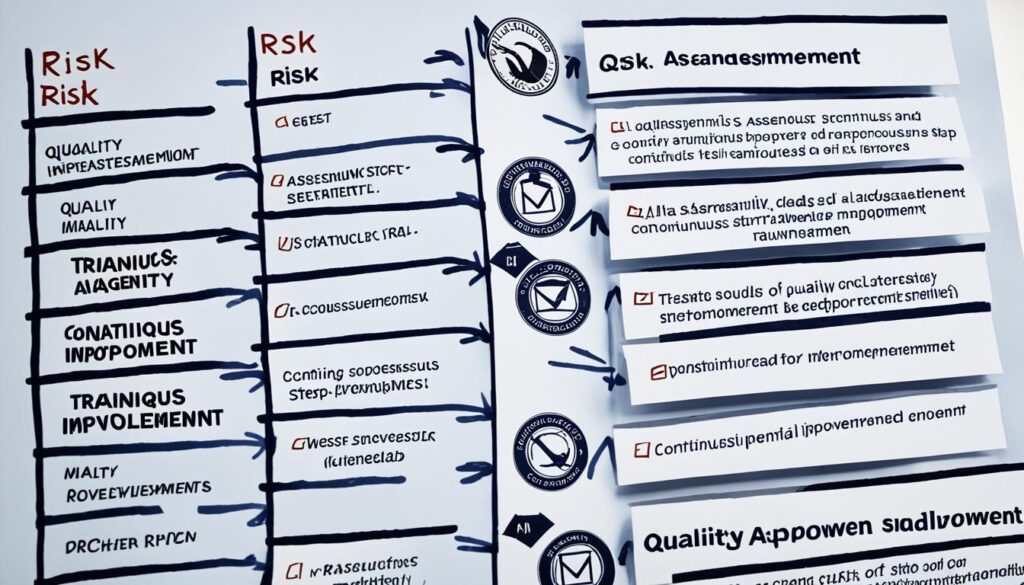Keeping a business safe means understanding and dealing with dangers. This is even more crucial in tough economic times. We need to look at both inside and outside threats. These dangers might harm our business. There are key steps to take. These include figuring out what risks matter most, getting insurance, and limiting how much we can be held responsible. It’s also important to have a team that watches for risks and works to prevent them.
Key Takeaways:
- Identify and address both external and internal risks.
- Prioritize risks based on their likelihood and potential financial impact.
- Buy insurance to transfer certain risks to insurance companies.
- Limit liability by transitioning to a corporation or LLC.
- Implement a quality assurance program to ensure customer satisfaction.
Prioritize Risks
The first step in managing risk is to rank them by chance of happening and their financial impact. This helps companies make a plan that deals with the most important dangers. By sorting and understanding risks, they can focus on the biggest challenges.
It’s vital to weigh risks by both how likely they are and how much harm they could do. This way, companies know which risks to deal with first. They can then use their energy and money wisely.
Risks at the top, highly likely to happen with big financial hits, are the top priority. They need instant action and solid plans to lessen their effects.
Yet, don’t forget about risks less likely to occur. Even rare risks can be costly. So, they need thought if they might greatly affect the business.
By setting priorities, companies get a better view of their risks. This lets them use their resources better. They can then apply actions where they matter most, increasing their chances of doing well.
Below is a sample of how to prioritize risks:
| Risk Category | Likelihood of Occurrence | Potential Financial Impact | Priority Level |
|---|---|---|---|
| Market Competition | Medium | High | High |
| Supplier Disruption | Low | Medium | Medium |
| Regulatory Changes | High | High | High |
| Technology Failure | Medium | Low | Low |
Buy Insurance
When managing business risks, it’s key to look at liabilities and follow legal rules. Think about your business’s needs and risks to decide what insurance you need. This step helps protect your operations.
Insurance is crucial because it moves the financial risk to insurance companies. It’s not usually expensive, but it covers huge potential losses. With insurance, your business is safe from unexpected events that could cost a lot of money.
There are many types of insurance for different parts of your business. This includes life, disability, professional, and completed operations insurance. Each type helps with specific risks, depending on what your business does.
Getting insurance doesn’t just lower your risks. It also keeps your business in line with the law. Many places need certain insurance for your business to run legally. Failing to get this insurance could lead to fines and harm your business and money.
“Buying insurance is a reliable strategy to protect your business from unexpected risks. It provides a safety net by transferring the financial burden to insurance companies, ensuring your business can continue to operate smoothly.”
Benefits of Buying Insurance:
- Protects your business from financial losses
- Provides coverage for potential liabilities
- Ensures compliance with legal regulations
- Offers peace of mind and financial security
To pick the right insurance, know your risks and understand your liabilities. Being aware of legal needs also helps you make good insurance choices. This way, your business can face the future with confidence.

| Types of Insurance | Key Features |
|---|---|
| Life Insurance | Provides financial support to beneficiaries in the event of the policyholder’s death |
| Disability Insurance | Offers income replacement if the policyholder becomes disabled and unable to work |
| Professional Insurance | Covers professional liabilities and errors that can occur in specific industries |
| Completed Operations Insurance | Protects against potential claims arising from work or services that have already been completed |
| Property Insurance | Covers damage or loss of business property due to fire, theft, or other covered perils |
Limit Liability
If you run a business by yourself, you may want to protect your personal assets. Switching to a corporation or LLC can help. This change makes sure that business debts and other problems are the company’s issue, not yours personally.
Setting up a corporation or an LLC means the business is seen as its own being, separate from you. So, if the business owes money or faces a lawsuit, it’s the company that handles it, not you directly.
Picture this: you’re the only one running a catering service. Everything belongs to you, and you’re on the hook for what the business owes. But if there’s a lawsuit or the business struggles, your own stuff, like your house or savings, could be taken.
Now, with a corporation or an LLC, the business stands alone. If there’s legal trouble, your personal things are off the hook. Only your company’s things might be at risk.
Choosing a corporation or an LLC not only keeps your home safe. It offers tax perks, lets you share ownership and management, and makes your business look solid to others.
Comparison: Sole Proprietor vs. Corporation vs. LLC
| Sole Proprietor | Corporation | Limited Liability Company (LLC) | |
|---|---|---|---|
| Liability | The owner is on the hook for all business debts and issues. | The corporation handles its own debts, keeping shareholders’ personal stuff safe. | The LLC manages its debts, safeguarding what its members own. |
| Taxation | You report business earnings on your own taxes. | Corporations file their own taxes. Shareholders might get taxed again on dividends. | The LLC picks how it’s taxed, which can be like a partnership, corporation, or just by the owner. |
| Ownership | The owner runs everything alone. | Ownership is through shares, managed by a director’s board. | Members own it, but they can decide how they want to manage and make decisions. |
Thinking of switching to a corporation or LLC but not sure where to start? Talking to a lawyer or business expert is smart. They’ll look at what you do, what you want, and how risky your business is. Then, they’ll help pick the best path for you.
Implement a Quality Assurance Program
Setting up a quality assurance program is key for a good name and happy customers. It makes sure companies always offer top-notch products and services. This creates trust and a strong market image.
A quality assurance program checks products and services carefully to meet the best standards. It does this by inspecting, checking for industry rules, and ensuring quality throughout the making or providing.
It’s vital to always update and improve how we test things. This way, companies can spot and fix problems quickly, keeping quality high and customers satisfied.
Having a quality assurance program goes beyond meeting rules; it’s about surpassing what customers expect and offering truly remarkable goods and services. It lets companies get ahead and keep their customers loyal.
Customer Service: A Pillar of Quality Assurance
Good customer service is a must for quality assurance. It’s about being there for customers at every step. Great service earns trust, solves issues, and makes customers happy.
It’s important to train staff well for customer inquiries, feedback, and complaints. They should respond promptly, offer specific help, and make sure all customer needs are taken care of.
Companies also need to listen to what customers say. Their feedback guides improvements, making quality assurance better over time.
The Benefits of a Quality Assurance Program
The perks of a quality assurance program are many:
- It boosts a company’s reputation, showing they are serious about doing a great job, which can bring in more customers.
- It helps save money by fixing quality problems early, avoiding expensive fixes or recalls later.
- It keeps customers happy with top-quality items and services, making them more likely to come back and spread the good word.
- It encourages businesses to always get better, which helps them stay competitive and meet customer changes.

A quality assurance program is an investment in a business’s future. It focuses on quality, wins over customers’ trust, builds a great name, and supports long-term growth.
Limit High-Risk Customers
Dealing with high-risk customers is a big part of avoiding business troubles. These are folks with bad credit histories. They might cause problems for your company. It’s smart to have them pay up front. This way, you protect your business’s financial health and steer clear of future headaches.
To pull off this policy well, you gotta spot these high-risk folks early. This means checking their credit thoroughly and looking at how they’ve paid in the past. Setting up solid steps to do this helps you handle the risks better. You can also decide on payment terms that are smart for your business.
Having people pay early helps keep your money safe and your cash flow strong. It means you get the money you need right away. This lower the chances of not getting paid at all or getting paid late. Keeping your cash flow healthy avoids any hiccups in your daily operations.
Having a way to know who’s high risk lets you figure out how much risk you’re taking. This helps you deal with them better. You might change how much credit you give them or ask for more security. A smart, early approach helps keep your losses low.
Focusing on high-risk customers and having the right rules in place can do a lot for your business. It protects your money and keeps your business strong. This way, you can keep moving forward without worry.
By being smart about risks, businesses can stay steady even when times are tough. They can face the challenges of a shaky economy and still stand strong.
| Benefits of Implementing a Policy to Limit High-Risk Customers |
|---|
| Minimizes financial risks associated with customers with poor credit |
| Protects cash flow by ensuring upfront payments |
| Enables proactive risk management and decision-making |
| Reduces the likelihood of non-payment or late payments |
| Safeguards business’s financial stability and operations |
Control Growth
Growth is good for business, yet it brings new challenges. It’s important to manage these risks well. Here are some tips on how to do it:
1. Employee Training
To control growth, invest in your employees. As your company grows, make sure your team is ready. They should have the skills for their new tasks.
Offering training and development boosts employee skills. This improves how your business operates.
2. Quality Over Quantity
In managing growth, quality should always come first. Aim to provide top-notch products or services. This builds strong customer trust and loyalty.
Being the best in your field sets you apart from others. It lays down a solid path for your business to grow sustainably.
3. Balancing Innovation with Stability
Innovation drives growth and keeps you competitive. Yet, balancing this with stability is key. Innovation can bring both rewards and risks.
By weighing these, you can choose the best innovations. This leads to steady and controlled growth for your business.
“Focusing on delivering exceptional products or services and maintaining high standards can help you build a strong reputation and customer loyalty.”
With these strategies, you can manage growth effectively. Always stay proactive and keep an eye on your business’s quality and stability.

Appoint a Risk Management Team
Businesses sometimes form a risk management team to handle possible dangers. This team can be made up of employees who know risk well. Or, companies can bring in an outside firm that’s an expert in managing risks.
An in-house team can save money for the company. Since they already work for the business, it’s cheaper than hiring from outside. Plus, they know the ins and outs of the company. This means they can make a risk plan that really fits.
If a company isn’t set up to manage risks or wants fresh eyes, hiring a firm might be the right call. These outside experts have seen a lot. They can offer new ideas on spotting and dealing with risks.
Whether it’s an inside or outside team, choosing the right people is critical. They need to know numbers, laws, and the business field well. Picking the right people helps a business tackle risks smartly.
Benefits of an Effective Risk Management Team
Having a risk team can help a business in many ways:
- Finding risks early: A skilled team can spot dangers before they become big problems.
- Evaluating and mapping risks: They figure out the chance and impact of risks, making a clear plan.
- Creating plans to lower risks: With a good map, they can come up with solid strategies.
- Save money by being ready: Being on top of risks can prevent big financial hits.
Creating a risk team helps a business deal with dangers before they become disasters. It’s a key part of staying successful in the long run.
The Importance of Risk Management
Risk management is vital for business success over time. It works like an insurance, shielding companies from dangers. By spotting and tackling risks early, they can grow better and protect their profit.
To do this, businesses should really look at what risks they face. This means digging deep into the specific challenges of their industry.
Creating a solid risk plan lets businesses find and handle threats. It aims to reduce how much these risks hurt the company. By doing this early, companies can protect their name and money, standing strong for years to come.
Preventing Risks for Sustainable Success
In risk management, the goal is avoiding dangers, not just dealing with them later. Businesses can do a lot to lower their risk level. This protects their money and makes them stronger overall.
- Implementing robust risk assessment processes to identify and evaluate potential risks
- Developing risk prevention strategies tailored to the specific needs of the business
- Establishing risk monitoring mechanisms to detect and address emerging risks
- Ensuring clear communication of risk prevention protocols and guidelines throughout the organization
Deep Dive into Risk Analysis
Tackling risks fully means going beyond the surface. Companies need to explore a lot, from market trends to their own processes. This gives them a full view of what could go wrong.
By doing a thorough risk check, companies find risks not everyone sees. They then can prepare early, keep up with changes, and stay ahead in business.
“Taking a deep dive into risk analysis allows businesses to proactively manage uncertainties, ensuring a strong and resilient foundation for sustainable success.”
The Benefits of Effective Risk Prevention
A good risk plan has many good effects on businesses:
- Enhanced Decision-Making: Knowing risks well helps companies make smarter choices. This means their moves fit their goals.
- Better Resource Allocation: Finding and focusing on risks helps spend money and time better. It increases the chances of winning.
- Operational Continuity: Managing risks well keeps business running, even when faced with surprises. This cuts down on troubles.
- Improved Stakeholder Confidence: Being active about risk boosts trust from investors, clients, and staff. They see the business as smarter and safer.
| Benefits of Effective Risk Management | Description |
|---|---|
| Enhanced Decision-Making | A thorough understanding of potential risks empowers businesses to make informed decisions and take calculated risks aligned with strategic objectives. |
| Better Resource Allocation | Identifying and prioritizing risks allows organizations to allocate resources in a focused and efficient manner, optimizing success. |
| Operational Continuity | Effective risk management ensures seamless business operations, even in the face of unforeseen challenges, minimizing disruptions. |
| Improved Stakeholder Confidence | A proactive risk management approach instills confidence among stakeholders, including investors, customers, and employees. |
The Categorization of Risk
Understanding risks is crucial for businesses to manage effectively. We group risks into three main types: preventable, strategy, and external. Each type requires a different approach to deal with them.
1. Preventable Risks
Preventable risks come from within the business. They can be stopped or lessened by good risk management. These risks are like bad operation processes, errors in work, or not enough security. When a company tackles these problems early, they lower the chance of harm.
2. Strategy Risks
Strategy risks are ones that companies choose to take. They do this to get more rewards or meet big goals. This kind of risk might happen when entering new markets or trying new tech. While these risks can bring big wins, there are no guarantees. Knowing how to weigh the benefits against the risks is key.
3. External Risks
External risks are things a company can’t control. These include things like natural disasters or sudden law changes. Since you can’t stop them, the best way to handle these risks is by preparing. For example, having backup plans, using different suppliers, or having insurance can reduce the harm they cause.
By knowing how to deal with each type of risk, businesses can stay safer. They can spot, measure, and lower dangers. Having a good plan that looks at all three risk types is vital for lasting success.
| Category of Risk | Description |
|---|---|
| Preventable Risks | Risks from inside organizations that can be managed or avoided. |
| Strategy Risks | Risks taken by businesses to reach their goals or get big returns. |
| External Risks | Risks from things beyond a company’s power, like sudden policy changes. |
Tailoring Risk Management Processes
Businesses need to customize their risk management to handle different risk types. They must use specific methods and tools. This should match the risks’ traits and nature they encounter.
A Rules-Based Approach for Preventable Risks
For risks that can be prevented, a rules-based method is key. It means setting clear rules, protocols, and procedures. This creates a solid framework to reduce mistakes, accidents, and failures. The focus is on sticking to the rules to cut down and handle risks well. This leads to a more consistent and compliant business.
Open and Explicit Risk Discussions for Strategy Risks
When it comes to strategy risks, a teamwork approach is better. These risks link to big decisions and new ideas. They need different views, brainstorming, and talk. Creating a setting where everyone openly discusses risks and chances helps. It guides how businesses deal with these risks, leading to smarter, long-term choices.
Anticipating and Mitigating Major External Risks through War-Gaming and Scenario Analysis
Dealing with big external risks, like natural disasters, is tough. Companies use war-gaming and scenario analysis to get ready for them.
War-gaming means simulating possible situations. It helps find weaknesses, understand various risks’ impacts, and plan actions. This allows companies to get ready for anything, reducing the chaos of sudden events.
Scenario analysis studies how different situations might affect a business. By looking at many what-if scenarios, companies can spot risks and opportunities. Then, they can come up with plans to lessen dangers and benefit from good chances.
By customizing how they manage risks to fit the different risk types, companies can tackle threats and chances early. This personalized strategy improves how they deal with risks and helps them stay strong in changing times.

Conclusion
Good risk management keeps businesses safe and helps them grow. By having a solid plan in place, companies can catch and deal with dangers early. This lets them focus on the most serious risks first.
To protect personal assets, it’s smart to set up your business right. This could mean becoming a corporation or forming an LLC. Also, making sure your products and services are top-notch helps keep customers happy.
When growing fast, it’s crucial to do it smartly. This means training your team well and finding the right balance between new ideas and staying steady. Having a team that’s all about handling risks or getting help from experts can make a big difference.
To sum up, managing risks well is key to staying in business for the long run. By looking closely at risk and making custom plans, companies can face any challenge. This is especially true in today’s fast-changing and competitive world.
FAQ
How do I prioritize risks in my business?
To prioritize risks, you must look at how likely they are and their financial impact. Give more attention to risks that are likely and carry a big financial burden. However, don’t forget about risks with lower chances.
Why is buying insurance important for managing business risks?
Insurance helps move risk to others at a lower cost than facing it alone. It’s vital to know your business’s risks and legal needs. Types of insurance to consider include life, disability, professional, and operations coverage.
How can I limit liability for my business?
Changing your business to a corporation or LLC can protect your personal assets. This keeps you from being personally responsible for debts or damages.
What is a quality assurance program, and why is it important?
A quality assurance program is about making sure products and services are top-notch. It builds trust and satisfies customers. Keep improving by regularly checking and fixing any issues.
How can I limit the risks associated with high-risk customers?
Have customers with bad credit pay upfront. It can prevent future problems. Setting up a way to spot high-risk customers early is also a good idea.
How can I effectively control the growth of my business?
Train your staff well to manage growth. Set reachable goals and aim for quality over quantity to reduce risks. While being innovative is key, balance it with staying stable.
Should I appoint a risk management team for my business?
You can make your own risk management team or hire experts from outside. Using internal experts saves money and ensures tailored strategies. But, if you lack the needed skills inside, hiring can be the best move.
Why is risk management important for businesses?
Risk management is vital for long-lasting success. It functions as a shield against dangers. Understanding your business’s risks well is key to an effective plan.
How can risks be categorized in business?
Risks come in three main types: preventable, strategy, and external risks. Preventable risks come from the organization and can often be stopped. Strategy risks are taken on purpose for greater gains. External risks are beyond your control, like natural disasters.
How should risk management processes be tailored for different types of risks?
To deal with risks, your approach should fit the risk type. For preventable risks, set clear rules. Strategy risks need open discussions. Try tools like scenario analysis for major external risks.
What are the benefits of effective risk management?
Proper risk management protects and grows your business. Prioritizing risks, buying insurance, and more all help. Being proactive about risks is vital in today’s fast-changing world.



















